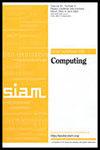分支宽度的快速 FPT 近似算法
IF 1.6
3区 计算机科学
Q3 COMPUTER SCIENCE, THEORY & METHODS
引用次数: 0
摘要
SIAM 计算期刊》,第 53 卷第 4 期,第 1085-1131 页,2024 年 8 月。 摘要枝宽决定了图以及更广义的任意连通性(对称和亚模态)函数如何通过特定切分分解成树状结构。我们开发了一个通用框架,用于设计连通性函数分支宽度的固定参数可控 2-approximation 算法。我们框架的第一个要素是组合。我们证明了一个结构定理,即要么一连串特定的细化操作可以减小分支分解的宽度,要么分解的宽度已经与最优值相差 2 倍以内。第二个要素是支持高效动态编程的分支分解细化操作的高效实现。我们介绍了一般框架的两个具体应用。第一个是一种算法,对于给定的[math]顶点图[math]和整数[math],它能在[math]时间内构造出宽度至多为[math]的[math]秩分解,或者得出[math]的秩宽度大于[math]的结论。它还能在相同的时间复杂度内得到一个[math]近似的秩宽算法,进而将各种算法在秩宽为[math]的图上的运行时间提高到[math]。打破秩宽和cliquewidth的 "立方障碍 "是该领域的一个未决问题。第二个应用是一种算法,对于给定的[math]顶点图[math]和整数[math],在[math]时间内要么构造出宽度至多为[math]的[math]分支分解,要么得出[math]的分支宽度大于[math]的结论。这比科尔霍宁(Korhonen)[FOCS 2021]最近提出的树宽 2 近似的 3 近似有所改进。本文章由计算机程序翻译,如有差异,请以英文原文为准。
Fast FPT-Approximation of Branchwidth
SIAM Journal on Computing, Volume 53, Issue 4, Page 1085-1131, August 2024.
Abstract. Branchwidth determines how graphs and, more generally, arbitrary connectivity (symmetric and submodular) functions can be decomposed into a tree-like structure by specific cuts. We develop a general framework for designing fixed-parameter tractable 2-approximation algorithms for branchwidth of connectivity functions. The first ingredient of our framework is combinatorial. We prove a structural theorem establishing that either a sequence of particular refinement operations can decrease the width of a branch decomposition or the width of the decomposition is already within a factor of 2 from the optimum. The second ingredient is an efficient implementation of the refinement operations for branch decompositions that support efficient dynamic programming. We present two concrete applications of our general framework. The first is an algorithm that, for a given [math]-vertex graph [math] and integer [math], in time [math] either constructs a rank decomposition of [math] of width at most [math] or concludes that the rankwidth of [math] is more than [math]. It also yields a [math]-approximation algorithm for cliquewidth within the same time complexity, which in turn improves to [math] the running times of various algorithms on graphs of cliquewidth [math]. Breaking the “cubic barrier” for rankwidth and cliquewidth was an open problem in the area. The second application is an algorithm that, for a given [math]-vertex graph [math] and integer [math], in time [math] either constructs a branch decomposition of [math] of width at most [math] or concludes that the branchwidth of [math] is more than [math]. This improves over the 3-approximation that follows from the recent treewidth 2-approximation of Korhonen [FOCS 2021].
Abstract. Branchwidth determines how graphs and, more generally, arbitrary connectivity (symmetric and submodular) functions can be decomposed into a tree-like structure by specific cuts. We develop a general framework for designing fixed-parameter tractable 2-approximation algorithms for branchwidth of connectivity functions. The first ingredient of our framework is combinatorial. We prove a structural theorem establishing that either a sequence of particular refinement operations can decrease the width of a branch decomposition or the width of the decomposition is already within a factor of 2 from the optimum. The second ingredient is an efficient implementation of the refinement operations for branch decompositions that support efficient dynamic programming. We present two concrete applications of our general framework. The first is an algorithm that, for a given [math]-vertex graph [math] and integer [math], in time [math] either constructs a rank decomposition of [math] of width at most [math] or concludes that the rankwidth of [math] is more than [math]. It also yields a [math]-approximation algorithm for cliquewidth within the same time complexity, which in turn improves to [math] the running times of various algorithms on graphs of cliquewidth [math]. Breaking the “cubic barrier” for rankwidth and cliquewidth was an open problem in the area. The second application is an algorithm that, for a given [math]-vertex graph [math] and integer [math], in time [math] either constructs a branch decomposition of [math] of width at most [math] or concludes that the branchwidth of [math] is more than [math]. This improves over the 3-approximation that follows from the recent treewidth 2-approximation of Korhonen [FOCS 2021].
求助全文
通过发布文献求助,成功后即可免费获取论文全文。
去求助
来源期刊

SIAM Journal on Computing
工程技术-计算机:理论方法
CiteScore
4.60
自引率
0.00%
发文量
68
审稿时长
6-12 weeks
期刊介绍:
The SIAM Journal on Computing aims to provide coverage of the most significant work going on in the mathematical and formal aspects of computer science and nonnumerical computing. Submissions must be clearly written and make a significant technical contribution. Topics include but are not limited to analysis and design of algorithms, algorithmic game theory, data structures, computational complexity, computational algebra, computational aspects of combinatorics and graph theory, computational biology, computational geometry, computational robotics, the mathematical aspects of programming languages, artificial intelligence, computational learning, databases, information retrieval, cryptography, networks, distributed computing, parallel algorithms, and computer architecture.
 求助内容:
求助内容: 应助结果提醒方式:
应助结果提醒方式:


